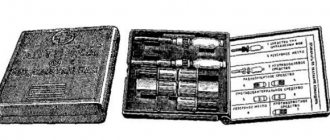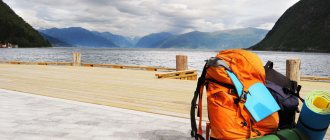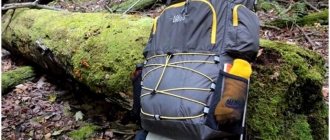Total information
The contents of the kit vary significantly depending on the intended situation and the planned actions in it. As a rule, the kit includes essential items: documents, maps of the district, city, region, food for three days, a set of underwear, personal hygiene products, location aids, cutlery, matches, candles, writing instruments, personal protective equipment.
On this topic ▼
Prefabricated evacuation point
Organization, purpose, equipment
In different fire departments, as well as in other law enforcement agencies of the Russian Federation, as a rule, the composition of the alarm kit is approved by the local order of the head at the place of service . Procedure for storing and checking completeness.
The alarm kit is allowed to be stored both at home and in the unit.
It should be remembered that when starting a shift, the emergency suitcase should always be in the unit, since when you are on duty for a day, there is no opportunity to leave the facility when civil defense signals are announced and personnel are assembled.
Each alarm kit is a medium-sized bag or backpack with a name tag indicating who it belongs to.
When announcing civil defense signals, as well as during the collection of all personnel, the alarm kit is checked by external inspection and the presence of items according to the approved list; the check can be either scheduled or unscheduled; the frequency of checks is established by the management of the unit.
First aid kit
A first aid kit is the second thing you should take care of when packing your emergency backpack. The most important ones are the medications that you or your family members take on an ongoing basis. These could be medications that lower blood pressure, insulin, inhalers, etc. As a rule, the alarm backpack is designed to be used within the first 72 hours, so it is important to provide yourself with the necessary medications. It is worth taking a particularly responsible approach to the selection of remedies for various poisonings and intoxications. People who have been in extreme conditions noted that often those around them simply did not have enough basic means against diarrhea that arose in unsanitary conditions or as a result of a nervous disorder. As a basis for a first aid kit, you can take an old type car first aid kit or products from it.
The first aid kit should also include:
- bandages, iodine, hemostatic dressings
- hemostatic tourniquet
- bactericidal adhesive plaster (packaging)
- adhesive plaster roll
- painkillers, antipyretic tablets (two in one)
- drugs used for various intoxications and poisonings (enterodes, smecta, rehydron, loperamide, activated carbon)
- syringes (insulin and regular)
- antibiotics and broad-spectrum antimicrobials (ciprofloxacin, tsifran, metronidazole)
- corvalol or valerian tablets (will help you fall asleep quickly)
- antihistamines
Medicines must be packaged in a sealed bag.
Bags for emergency suitcases.
If you don't need a bag, order a complete toiletry case.
A travel bag is convenient!!!
date and time
Emergency suitcase: composition for employees, employees of the Ministry of Emergency Situations, Ministry of Internal Affairs
The material contains a list of necessary things, compiled in advance and used for their intended purpose in the event of an unforeseen emergency, natural disaster, emergency or martial law. Among employees and workers of the Russian Ministry of Emergency Situations, this kit also goes by the following names: “alarm suitcase”, “alarm suitcase”, “alarm backpack”, “thing bag”, “defense suitcase”, hereinafter referred to as the kit.
Total information
The contents of the kit vary significantly depending on the intended situation and the planned actions in it. As a rule, the kit includes essential items: documents, maps of the district, city, region, food for three days, a set of underwear, personal hygiene products, location aids, cutlery, matches, candles, writing instruments, personal protective equipment.
In different fire departments, as well as in other law enforcement agencies of the Russian Federation, as a rule, the composition of the alarm kit is approved by the local order of the head at the place of service . Procedure for storing and checking completeness.
The alarm kit is allowed to be stored both at home and in the unit.
It should be remembered that when starting a shift, the emergency suitcase should always be in the unit, since when you are on duty for a day, there is no opportunity to leave the facility when civil defense signals are announced and personnel are assembled.
Each alarm kit is a medium-sized bag or backpack with a name tag indicating who it belongs to.
When announcing civil defense signals, as well as during the collection of all personnel, the alarm kit is checked by external inspection and the presence of items according to the approved list; the check can be either scheduled or unscheduled; the frequency of checks is established by the management of the unit.
List and list of things
List of things in the emergency suitcase
- personal protective equipment;
- token with personal number;
- map of the city, district, region;
- passport, ID, passes, driver's license;
- set of pencils, fountain pen;
- command line;
- penknife;
- compass;
- a pair of underwear;
- handkerchiefs, socks, threads, needles;
- food for three days;
- tableware and toiletries;
- notepad or notebook, envelopes;
- flashlight, candle, matches.
Complete set of the “Alarm suitcase!” Example of packing an emergency suitcase
Well, I hope your knees aren't shaking anymore?
Personally, the earthquake woke me up, I don’t know how, but the natural “alarm clock” worked perfectly. First of all, not having time to fully open my eyes, but already clearly understanding that it was an earthquake, I pulled on my pants, grabbed a T-shirt and cell phone and ran after my mother to take her outside. To be honest, I performed all these actions “automatically” and only then realized that, in general, I did not react badly. But I had a serious hitch that could have cost me my life. I began to think about what to take with me and where it was.
It just so happened that, unlike the smart Japanese whom life has taught us, we are not accustomed to collecting the “Alarm Suitcase”. Although we have been waiting for 100 years for that same destructive earthquake. And what should I put there? The fact is that there are a lot of forums and on each they write their own “composition” of the alarm suitcase. This is correct; in my opinion, each region should have its own content, taking into account the characteristics of the environment.
Let's try to figure out what can be useful to us in an emergency and what to put in the “alarm suitcase”.
Firstly, the alarm suitcase is not a suitcase at all, as it might seem at first glance. This is a backpack or duffel bag, and quite voluminous.
A properly equipped bag should help you survive in an emergency situation when there is no water, food, heat, or shelter nearby.
The accepted minimum of autonomous stay reserves is for three days . This is partly due to the time in which emergency services promise to respond and intervene in the situation, warm and feed the victims.
I will say right away that the volume of such a backpack should be approximately 100 liters in order to fit everything you need. The backpack should be chosen from high-quality materials, with an anatomical shape and a rain and snow cover. Fortunately, it’s not difficult to find one like this in our city. It is imperative to identify the owner, especially if the backpack belongs to one of the household members. Let’s say this particular backpack contains pills for a child for asthma, and mixing up the backpack in this case can be a fatal mistake.
Color:
No need to take a camouflage backpack and clothes. If a political or military conflict suddenly occurs, a person wearing camouflage will automatically be considered a participant, and this is already life-threatening. They might take it for the wrong person. The color should not be flashy, and not camouflage - green, brown, gray!
The alarm case is equipped 50-60% for a specific person. But you still need to simplify everything as much as possible. You should not collect everything that comes to hand, grandma’s china or silverware. Believe me, in the event of a nuclear attack, porcelain will not help you in any way, except perhaps drink vodka from beautiful mugs to relieve radiation shock.
sample packing of an emergency suitcase
Package
How to properly pack things in a backpack? There is no clear definition on this matter, but still heavy things should be placed closer to the back, pills, a knife, a flashlight and all things that may be needed quickly - in special. backpack pockets.
It is very important to know where and what is. Things should be wrapped in plastic before packing; if water gets into the backpack, there will be a greater chance that the things in it will be dry.
In addition to polyethylene, it is very convenient to use food or special plastic containers. They fit comfortably in a backpack and also protect from moisture and mixing.
In such a container you can put medicines, matches, socks and thermal underwear, food, batteries, and a radio. In general, everything that needs to be protected from moisture.
Such a container can also serve as a container for food or a washbasin. You can take fishing containers. But don’t overdo it, because it’s extra weight in your backpack!
Documentation
After surviving, we need to somehow continue to live. And documents can play a key role in this process. For this reason, they need to be approached with special attention.
Be sure to make color or black and white copies of all necessary documents: passport, documents establishing property rights, military ID or registration certificate, identification, etc. If possible, they can be notarized. It is advisable to write them onto a disk or flash drive and pack them in water-resistant packaging.
Let me remind you again that documents can play a huge role in how you continue to exist.
Cloth
With clothes everything is much more complicated. The fact is that it is impossible to guess at what time of year an emergency will occur. Therefore, the set of clothes should be neutral, suitable for winter and summer.
Thermal underwear is a must. Glory to the man who invented it.
There are several pairs of socks, including thermal socks. They are thin and hold heat well.
Jacket - light, waterproof In the jacket and pants, it is advisable to have a large amount
pockets. Hat and gloves. Gloves can help if you need to protect and also warm your hands.
Long johns, underwear - several pieces.
Shoes are an ideal option - ankle boots or grinders, they will protect the ankle, and most importantly, they do not get wet and are usually of quite high quality. It is better to choose an autumn type - wearing a woolen or thermal sock, you can walk normally in winter.
Important: do not choose camouflage clothing!
There are different emergency situations, incl. and caused by the human factor - wars, interethnic clashes, revolutions. In conditions of such social unrest, anyone dressed in camouflage will look like a potential participant in the conflict. Accordingly, the risk of being detained or even killed by one of the parties to the conflict increases many times over. And this fact proven by practice must be taken into account.
On the other hand, camouflage provides good camouflage in nature. And if the emergency is not associated with the social unrest described above, then camouflage overalls may well become extremely convenient in an extreme situation, as well as protect you from the eyes of prying eyes if emergency conditions force you to spend some time in nature, outside the city.
It is best to buy camouflage workwear for an alarm backpack that matches the color scheme of the environment in your region.
Products
It is food that should give you strength for further struggle and existence.
And the very first thing you should put in your emergency suitcase is, of course, stewed meat . It can be stored for a very long time (up to 3-4 years), is resistant to damage, nutritious and tasty. The only noticeably serious disadvantage of the stew is its weight. 5 cans will significantly make your entire “ammunition” heavier. So calculate your strength correctly!
The food industry does not stand still and now there are a lot of all kinds of instant cereals. For example, buckwheat porridge with beef or soups in mugs. Convenience lies primarily in its light weight and speed of preparation, usually 5-7 minutes. But the downside is that such a product does not last long - about 1 year.
Crackers - having them is a must. They are light and nutritious, and can also be stored for a very, very long time. The crackers should be stored in a container or polyethylene, protected from moisture.
Drinking water
I don’t think it makes sense to explain how important water is.
I will say that the water supply should be enough for at least a couple of days. It is better to take water from the store, so it can be stored sealed longer.
Water from reservoirs is another matter; fortunately we live among mountain rivers and a huge number of lakes. Here it is necessary to properly disinfect such water; for this there are tablets: pantocid (1-2 tablets per 1 liter of water), aquatabs or potassium permanganate crystals (dilute until a pink color appears and let sit for an hour). And of course, one of the most reliable ways to disinfect suspicious water is boiling.
Since we live in the mountains, there may not be problems with water. There may be problems with its use. It is advisable to have a straw with you, with which you can drink from a spring or puddle without muddying the water. This is what I do with shepherds using a hollow chicken bone instead of a tube.
It would be nice to have wet and dry wipes, toothpaste, sanitary pads for women, a razor with replaceable blades, paper and soap with you!
Medicines
The main problem with medications is that not everyone is familiar with medicine and how to properly use a particular drug. In what cases should it be used? Here, too, you need to take an individual approach and put in those medications that are necessary for you.
But there is a so-called standard set of what it is advisable to pack in your emergency backpack.
- Validol - neuroses, hysteria, angina pectoris.
- Valocordin, Corvalol - neuroses with increased irritability, insomnia, tachycardia.
- Suprastin - allergic reactions.
- Aspirin or Paracetamol is an anti-inflammatory, antipyretic and analgesic agent.
- Levomycetin or Ciprofloxacin is a broad-spectrum antibiotic.
- Activated carbon - detoxification during intoxication, diarrhea, poisoning with heavy metal salts, food intoxication, dysentery, poisoning with chemical compounds, allergic diseases, alcohol withdrawal syndrome, intoxication, etc. Used at the rate of 1 tablet per 7-10 kg. weight.
- Imodium (loperamide) - treatment of acute and chronic diarrhea.
- Phthalazole is an antimicrobial agent for the treatment of dysentery, gastroenteritis, enterocolitis, colitis and other infectious and inflammatory diseases of the gastrointestinal tract.
- Pentalgin or Analgin - pain syndrome, migraine, toothache and headache, pain from injuries, burns, fever syndrome.
- Phenazepam or Donormil is a sleeping pill.
Dressings:
- Sterile bandages 7?14 - 5 pieces.
- Medical cotton wool, roll 50 g - 1 piece.
- Antibacterial adhesive plaster, package (or a couple of dozen pieces).
- Rolled adhesive plaster 3×500 cm – 1 roll.
- Individual dressing package - 1-2 pcs.
Antiseptic agents:
- Zelenka, iodine - fresh postoperative and post-traumatic scars, abrasions, cuts, violations of the integrity of the skin.
- Hydrogen peroxide is used as an antiseptic. Promotes blood clotting and creates unfavorable conditions for the development of microorganisms.
- Potassium Permanganate (potassium permanganate) - an antiseptic for gargling, washing wounds, treating burns. As an emetic for oral administration.
Taken from open sources.
Fire
In survival conditions, getting fire is vital. For heating and cooking, to boil water, as a distress signal, lighting, disinfection, etc.
Matches are needed when it is difficult to get anywhere, for example to light a kerosene lamp. It is better to take hunting matches that do not get wet and do not go out.
Dry alcohol is an alternative source of fire, as well as a means for igniting a fire. It is lightweight and sold almost everywhere.
Lighter - Put about 5 lighters in your backpack and you shouldn’t have any problems getting a fire. They do not deteriorate, do not break and are stored for a very long time.
Flint is perhaps the most useful thing for making fire, if, of course, you know how to use it. This is a rod, knocking sparks out of which with a knife you can light a fire. Costs from 3000 - 5000 tenge in any hunting store.
In addition to everything listed above, you need a knife , or better yet more than one. A good knife is the key to good survival. The knife must be chosen according to your needs. Well, in general, there are ready-made knife solutions in our stores designed specifically for survival. I’ll talk about the survival knife another time because this is a very important topic that requires a lot of detail.
In addition to the knife, put:
- Threads and needles
- A camping hatchet, it is not large
- Folding cup
- The flashlight is preferably inertial, which does not require batteries
- If possible, radio
- Scotch tape and duct tape
- Multitool - a knife with a bunch of tools
- Raincoat
- If there is room left - a sleeping bag
I hope you never need a backpack like this. But having one in your home, car or work is essential.
Add in the comments your options for what you would put in the emergency suitcase.
I'm on Twitter
Backpack contents
1. Backpack
In fact, the emergency suitcase is only called a “suitcase”; in fact, it is a capacious backpack of more than 30 liters. You need to be prepared for the fact that you have to go through a serious hiking trip with him behind you.
Not to work, not to the store and not to the car.
2. First aid kit
There is a simple and standard list of necessary medications and materials that will have to be taken. It is important to understand that each first aid kit is individual.
3. Drinking water
You can store drinking water in a plastic bottle: drinking water will not spoil for about six months.
4. Products
There is no need to put a chicken leg in a suitcase - you will get tired of carrying it. Take what you really need: sugar, salt, bread, stewed meat, candy, instant noodles, etc.
5. Dishes
In addition to the standard set of a bowl, mug, knife and spoon, you need to take a waist flask and a kettle. Not a huge, round cauldron, but an army, small, “Soviet” cauldron. Its lid, by the way, is used as a frying pan.
6. Fire
There is no need to take several lighters, as many people advise; in the cold, the gas decreases in volume and it is difficult to light the lighter. Ideally, take the simplest thing with you - flint. The main thing is to learn how to use it in advance.
Tourist matches will also help out. Pack them hermetically in a bag: if the matches themselves get wet, they will not lose their properties, but setting them on fire on a soggy box will not be easy.
Use “dry fuel” in tablets as fuel.
7. Hygiene products
Simple list:
- Soap
- A razor with a set of additional removable blades or disposable razors.
- Toothpaste and brush
- Several packs of disposable dry tissues/wipes
- Handkerchief
- Toilet paper roll
- Nail scissors or tweezers
- Feminine hygiene products
- Towel
8. Documents
Without documents in an extreme situation, it will be much more difficult to “break through”, so the minimum amount should always be: passport, insurance policy, driver’s license.
Also pack them in a waterproof bag to prevent them from getting wet.
Just in case, you need to make photocopies and put them in different pockets.
9. Repair kit and other tools
It's better not to skimp on these things. This is the same case when the stingy one pays not twice, but much more. Take high-quality tools and devices, otherwise they will break.
The list of these things includes:
- Threads and needles
- Nice knife
- Saw or ax
- Several pairs of gloves
- Several flashlights
- Sapper shovel
10. Clothes
There are several conditions under which clothes will end up in the emergency suitcase. It should be comfortable, of good quality, waterproof and keep you warm. First of all, pay attention to thermal underwear!
11. Communication and information access devices
Be sure to take a small radio receiver with the ability to receive VHF or FM bands in order to be aware of what is happening. There are cheap dynamo receivers on the market. Otherwise, you will have to stock up on batteries. You can take the simplest mobile phone with a charger.
12. Orientation
In any critical situation, a regular paper map will help you. Any equipment can get jammed, and it may happen that the compass won’t work. Although the compass, the simplest one, be sure to take it with you.
You shouldn’t rely on a smartphone and navigator in case of an emergency. Any technique can play a cruel joke on a person.
Features of the emergency suitcase for the Ministry of Emergency Situations, the Ministry of Internal Affairs and other departments
Any set of emergency suitcase, regardless of its origin, be it a suitcase for the civilian population, employees of the Ministry of Emergency Situations, the Ministry of Internal Affairs or other departments, has a number of important features.
Dishes. You can supplement the standard set of utensils, consisting of a knife, spoon, bowl and mug, with an army cauldron, the lid of which can be used as a frying pan or plate.
Drinking water. It is better to use plastic containers to store water; it will retain all its taste for six months.
Fire. It is irrational to take lighters in an emergency suitcase, no matter how high quality they are. At low temperatures, gas tends to compress, which can make it difficult to light a lighter. The ideal solution is flint. More often they use travel matches, which are hermetically sealed to avoid getting wet. If damp matches do not lose their original properties, then removing the boxes can cause a lot of trouble in the future.
Products. The “extreme” diet includes products with a long shelf life: stewed meat, instant noodles, diet bread, etc. Your own food set is often replaced with army dry rations; Each package is designed for daily consumption and contains all the microelements and vitamins necessary for the human body.
First aid kit. The composition of a traveling first aid kit consists of a standard list of medications and supplies necessary for the owner of a “GO suitcase.” It is worth clearly understanding that the first aid kit is individual for each EMERCOM employee.
An alarm case is a unique tool that can save a person’s life and health in the most difficult conditions. Neglecting the rules for its configuration can cause dire consequences, therefore, the units of the Russian Ministry of Emergency Situations pay special attention to this issue, constantly improving the set of items included in it.
Article sent by: Wladimir01
I like (24)
Articles on the topic
0 33
Fire safety in primary school
Published: March 15, 2017
Instructions
Procedure for collecting a civil defense suitcase
Organizing all your gear in your backpack is a science that requires years of experience. But simplified, it looks like this:
- the most voluminous things (sleeping bag, spare warm clothes, bowler hat) are placed at the bottom of the backpack;
- the middle is the heaviest (tent, heavy food, axe, saw, etc.);
- the top is filled with light, fragile things (first aid kit, groceries, etc.);
- small things are placed in separate pockets on the side or on top, the search for which should not take much time (documents, flashlight, candles, raincoat, water bottle).
A properly assembled emergency bag is any survivalist's best friend. It has everything: protection, shelter, food. This is your home on your back during an emergency. You need to take seriously its configuration and contents, which will help you properly prepare for any turn of events.
- about the author
- Recent publications
Alexander Gruber
Former rescue diver of the Ministry of Emergency Situations. Today he is in a well-deserved retirement. I love travel, tourism, hunting, fishing. I am happy to share my experience.
Alexander Gruber recently published (see all)
- Fishing for the Croatian egg: fishing features, types, how to do it yourself - 04/08/2020
- Hammock tent: how to choose, how to use and how to make it yourself - 03/08/2020
- Heatstroke in a bathhouse: how not to overheat in a steam room, and how to properly provide first aid - 03/01/2020
This is interesting: Preparing for appearances in the media. How to give an interview correctly
Food Ingredients
When considering the items included in the emergency kit, you should separate items related to nutrition into a separate group. Firstly, it is drinking water. It can be stored in a plastic bottle. Such containers are quite light and may not deteriorate for six months.
Secondly, it is important to decide on the products that will be useful on a long hike. In the event of an emergency, it is best to take with you only the essentials: salt, sugar, crackers or bread rolls, candy, stewed meat, instant noodles and cereals, and other non-perishable products.
Thirdly, it is important to choose the right dishes. In the travel kit you need to store unbreakable dishes (bowl, mug, spoons, knife, fork), as well as a pot and a flask that is attached to your belt. You need to take a small, army-style bowler hat. A container like a “Soviet” pot is especially good because its lid is used as a frying pan.
Fourth, you need to take fire. The best option would be flint (lighters often fail on long trips). This also includes travel-type matches, which must be placed in a sealed, waterproof package. It’s best to stock up on dry fuel in tablets.











